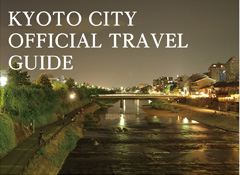【Places You will want to visit Again and Again】
Popular Temple Course Depicting the Essence of kyoto

Sanjusangen-do Temple
Gaunkyo
Tofuku-ji Temple
To-ji Temple
Start!
Hakubutsukan Sanjusangendo-mae stop
-

Public toilet on northeast corner of
Yamatooji-dori and Shichijo-dori
Sanjusangen-do Temple
-
The formal name of this temple is Rengeoin Temple. Shogun Kiyomori b uilt i t in the H eian pe riod, and gifted i t to Goshirakawahouou (ex-emperor and later a monk). The main hall is a long narrow building, some 120 meters in length. And, as there are 33 spaces between the pillars on the front side, the temple became known as "Sanjusangendo", or "hall with thirty three spaces". The main hall houses the main tourist attractions, starting with the "chuzon" (main image) of a seated statue of the Thousand-armed Kannon, which is flanked on either side by 500 other such statues, making a grand total of 1001 statues comprised as the main image of this temple. Yet, all the statues are arranged in way that the features and varying countenances of the faces of each can be seen clearly. In front of the massive array of the main image stand the Nijuhachibushu (28 attendants of Senju Kannon) as well as the wind god Fushin and the thunder god Raijin. All of which are National Treasures. 
Toilet in grounds of Sanjusangen-do Temple 
Public toilet at Sanjusangendo bus pool
Tofuku-ji Temple
-
At the beginning of the Kamakura period (1185-1333), the statesman Kujo Michie decided to found the largest temple in the capital, naming it Tofuku-ji by splicing together the parts of the names of the famed Todai-ji and Kofuku-ji in Nara. It was famous for its large temple buildings, but most of these burned down in a fi re in 1881. However, precious architectural insights to the Muromachi period and Zen lifestyle at that time remain, such as the sanmon gate (national treasure) as well as the bathroom and toilet (tosu) (important cultural assets). In the grounds, the Tsutenkyo bridge is renowned as a spot for viewing the autumn vista. Wheelchairs a re available t o m ake s ightseeing m ore enjoyable for the disabled. And, some of the explanation signs in the grounds are provided in English, Chinese and Korean. 
Toilet next to Nikkamon gate in Tofuku-ji Temple 
Toilet in grounds of Tofuku-ji Temple
To-ji Temple
-
This temple is formally known as Kyooukoku-ji Temple, and was built to protect the nation when Emperor Kammu was establishing the capital in ancient Kyoto. In 823, it was handed into the care of the monk Kukai (later to be called Kobo Daishi). Kodo hall (important cultural asset) houses 21 Buddhist statues, centered around the Dainichi Buddha and including national treasures like Godaimyoou (five great wisdom kings). Also, in the temple grounds can be found a five-tier pagoda (national treasure), which at approximately 55 meters tall is the tallest pagoda in Japan. In 1994, the temple was registered as a World Heritage Site.

Toilet next to Kitadaimon gate of To-ji Temple 
Toilet next to office of To-ji Temple 
Toilet next to Daishido hall of To-ji Temple 
Toilet next to Dainichido hall of To-ji Temple















